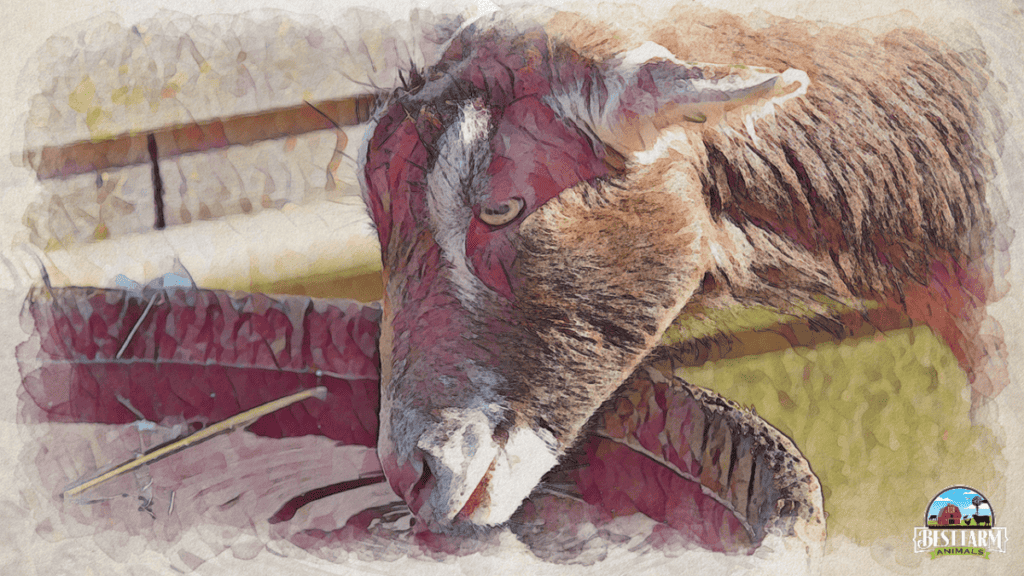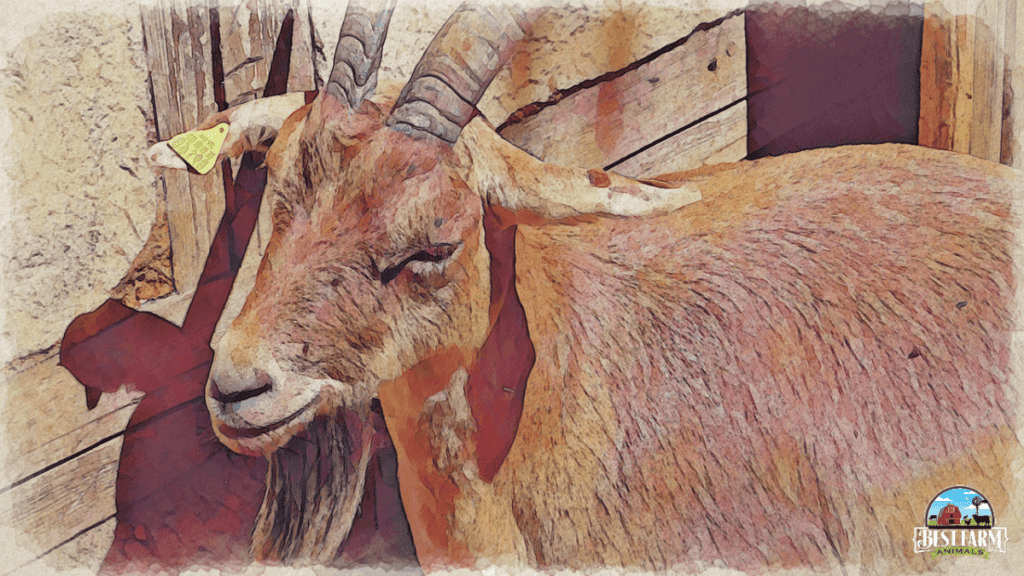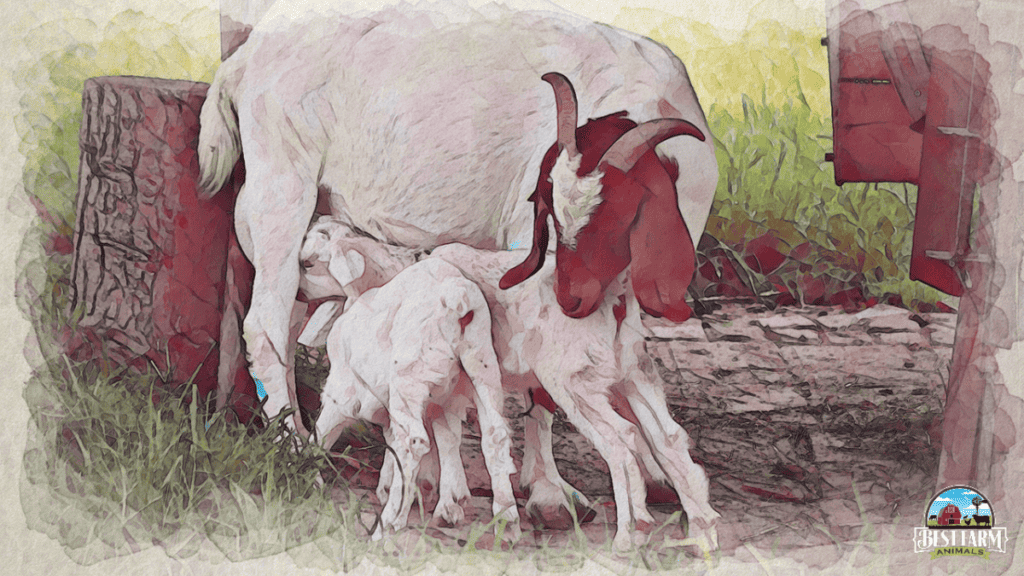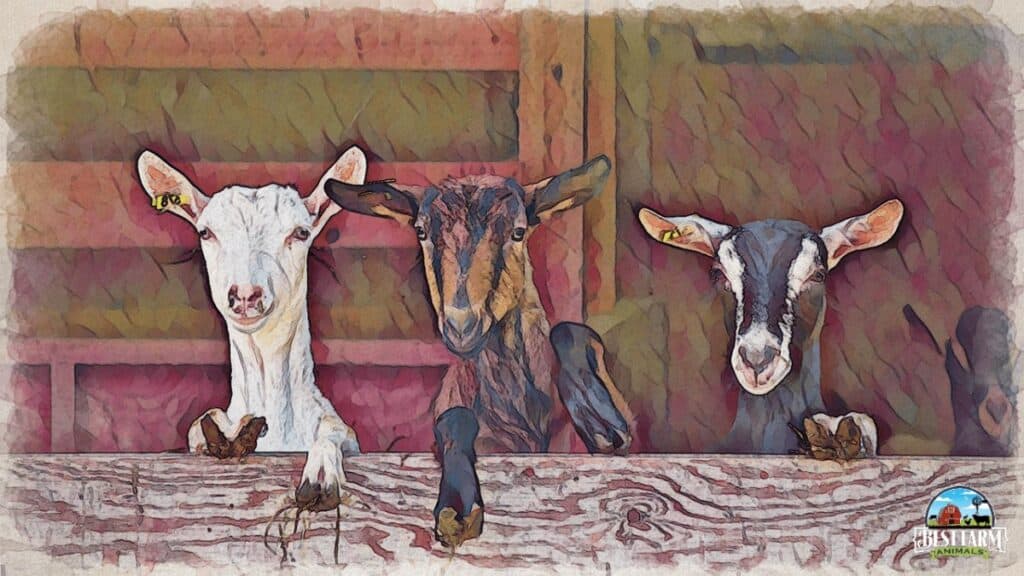
Exposure to scorching temperatures is just as much of a health hazard to goats as it is to humans. Goats are generally pretty hardy creatures, but heat can still affect them. And it’s a worry for many farmers and owners of pet goats.
Do Goats Sweat? Healthy goats don’t sweat, but a severely overheated goat will sweat. Goats don’t have sweat glands, so sweating is a warning sign. If a goat is sweating after exposure to hot weather conditions, it is usually a sign that they suffer from heatstroke and need immediate help.
Under normal circumstances, goats release heat through their horns and by panting, similar to a dog. However, when suffering from extreme heat stress or heat stroke, their bodies will use every vice possible to release heat, including sweating.
If your goats are sweating, they are in serious danger. Let’s take a look at the dangers and signs of overheating and what to do if it happens. Let’s take a look!
How Hot is Too Hot For a Goat?
A comfortable environmental temperature for a goat is between 32℉ and 86℉. Temperatures above 86℉ can cause goats to experience heat stress, leading to desperate sweating and dehydration. High humidity makes this more likely. Prolonged exposure to temperatures above 86℉ can cause goats to experience heat stress and dehydration.
A goat’s normal body temperature is between 102℉ and 104℉. If a goat’s body temperature rises above 104℉, they are at serious risk of developing heat stroke.
Newborn goats, young kids, pregnant goats, and elderly goats can be susceptible to overheating at slightly lower temperatures because their immune systems are more vulnerable. Outside of pregnancy, female goats tend to handle the heat better than male goats. Pregnant goats and older goats are also more vulnerable. High humidity increases the likelihood of heat stress and dehydration, whatever the temperature.

Common Signs of Heat Stress in Goats
Goats don’t usually sweat. But when they do, that could mean they’re heat-stressed due to extremely hot temperatures. Some of the early signs of heat stress in goats are:
- Excessive panting
- Trouble breathing
- Overall weakness
- An inability to stand up or walk
- Sweating (Advanced)
- Collapse/unconsciousness (Advanced)
Sweating and collapsing are signs that a goat needs urgent veterinary attention. A healthy goat will eliminate heat through its horns and by panting. However, a goat suffering from heatstroke may appear to sweat as a last resort to release heat from the body.
Do Goats Pant When Hot? Goats pant when hot because panting is eight times more effective at dissipating heat than sweating is (especially with fur). Hot goats will also dissipate heat through their horns and sweating.
A panting goat is in danger of dehydration so it’s critically important that you provide constant access to fresh water.
Do Goats Have Sweat Glands? Goats do not have sweat glands, but they can sweat a little by dissipating natural moisture in their skin. This method is not as effective as how humans sweat because sweating is an ineffective way to cool off. Instead, goats pant to cool down.

The Dangers of Overheating In Goats
A goat becomes dehydrated when they lose more fluid than they take in. The likelihood of dehydration occurring increases in hot temperatures. Hot conditions cause the body to release more fluid to keep cool. When severe, dehydration in goats can stop the body’s essential systems from functioning properly and even result in death.
Mild heat stress can occur in a goat when they experience prolonged exposure to high temperatures over 86℉. This can compromise the immune system, making them more susceptible to developing conditions like pneumonia, which is common in goats during the summer months. It can also cause infertility in both sexes. Males badly affected by heat stress can take 6-7 weeks to start producing fully functional semen again.
Heat stress can progress to heatstroke when left untreated, especially in high humidity. Heatstroke occurs when the animal affected can no longer regulate its internal temperature due to extreme heat. It is extremely dangerous; the animal’s organs will shut down if left untreated.
What To Do When Your Goat Is Heat Stressed
Move goats suspected of having mild heat stress to a cool, shaded area with good airflow. Offer your goats fresh water and encourage them to drink regularly. You can also spray cool water over their heads, legs, and stomachs, but be careful not to use icy cold water as it can shock the vascular system and worsen the situation.
After 20 minutes, take the goat’s temperature. If their temperature and behavior have not returned to normal, you should contact a vet as soon as possible for an examination. Goats displaying symptoms of heatstroke, such as unconsciousness, should be seen by a vet immediately.
Vets will gradually and safely reduce the goat’s body temperature back to normal with IV fluid treatment.

Signs of Goat Dehydration
A mildly dehydrated goat may lack energy and appear depressed, not playing or interacting with other goats as much as usual. They may have a dry nose, sunken eyes, and their head and ears may appear droopy.
Signs of more severe dehydration in goats include:
- Loss of appetite and weight
- Loss of skin elasticity
- Dry, pale gums
- Less frequent urination or no urination at all
- Collapse/unconsciousness
The skin elasticity test is a good way of telling whether a goat is dehydrated. To perform the test, lightly pinch the skin on the back of the goat’s neck. They are likely dehydrated if it does not instantly bounce back into place when you let go.
Another way to tell if a goat is dehydrated is by testing the capillary refill time of the gums. You can do this by gently pressing your finger against the goat’s gums until it turns white. If it takes more than 2 seconds to return to its normal color when you take your finger away, the goat is dehydrated.

What To Do When Your Goat is Dehydrated
A mildly dehydrated goat should be encouraged to take regular small drinks from a fresh supply of clean, cold water.
Goats that are more severely dehydrated should be given water with electrolytes. Electrolytes promote the rapid absorption of nutrients and energy and help restore goats’ fluid balance. One of the best, most popular, and highly-rated electrolyte products for goats on the market is made by Manna Pro (on Amazon).
Animals that are so severely dehydrated they cannot drink should receive intravenous fluid treatment by a vet as soon as possible.
Preventing Heat Stress In Goats During Summer Months
Thankfully, there are plenty of simple ways to prevent your goats from overheating. Not all of these options are viable for every goat owner, but you can keep your goats safe and healthy by taking precautions. This is especially critical in hotter or more humid climates.
Provide Shade and Shelter From The Sun To Prevent Heat Stress In Goats
First and foremost, farmers should provide adequate shade, such as trees or shelters in outdoor areas. Indoor spaces should have plenty of ventilation and airflow. In particularly humid areas, fans can be a great addition to help keep goats cool.
Goats Need Constant Access to Fresh Water
Goats should have constant access to clean, cool drinking water. On average, a goat will drink around 1-2 gallons of water daily. In hot weather, farmers should increase the amount of water provided. Putting frozen water bottles in the water trays is a super simple, inexpensive way to keep the supply cool. If you have a larger herd, make sure that there are watering options around the field so that all your goats have access to water. Limiting the number of watering options may mean that some goats don’t have access to all the water they need.
Shear Goats In The Spring To Help With Summer Heat
Although goats should be sheared in the spring to keep them cool in the upcoming months, you should avoid shearing them during the summer. This may sound counterproductive, but research shows that goats and sheep with a short fleece are more comfortable in the heat than those without, as wool fibers dissipate heat more rapidly and protect the skin from sunburn.

Only Dehorn Goats If Necessary (Such As With Milk Goats)
You should also avoid dehorning your goats. As mentioned above, a goat’s horns release heat and act as a radiator for their body, making them an important part of their internal temperature regulation. Many farmers dehorn their goats for economic and safety reasons, which may be necessary if you have hundreds of them.
However, unless you have a specific reason for dehorning your goats, consider letting them be. Goat horns are not dangerous to people and make handling them easier. Plus, this will significantly reduce the risk of your goats becoming overheated. Goats with horns can handle hotter temperatures better than dehorned goats.
Milk goats are one exception as dehorning milk goat breeds is often necessary so that they can use the milk stand. Plus many milk goat breeds, such as Sanaans are light-colored goats that stay cooler better.
Adjust Feed and Feeding Time For Hot Weather
Finally, farmers should adjust the goat’s feeding and breeding routines accordingly. In extreme heat, goats will want to graze when it’s coolest outside, in the early hours of the morning and later on in the evening. They should also be fed less feed and allowed more time to rest. Breeding should be avoided on hot days and done at night when it’s cooler.
Provide Misters To Cool Area on Extremely Hot Days
Another great tool for cooling down goats in the summer months is indoor mist systems. Water misters spritz animals with cool water regularly throughout the day. For outdoor spaces, consider sprinklers, which will help keep goats cool and can be lots of fun for them too. Many goats are playful and fond of water.
Should I Bathe My Goat?
Bathing your goats on hot summer days is a great way to help cool their bodies. Bathe them in the morning or evening because pouring cold water on them when they are very hot can shock their internal body temperatures, which is unhealthy. When bathing goats, use cold and clean water to achieve your goal and prevent infections. Use a water sprayer if you have many goats.

Goat Sweat FAQs
Can You Put Ice In A Goat’s Water? Putting ice in your goats’ drinking water is a great way to cool their bodies in the hot summer. You can use ice blocks, but these may not last long. Instead, fill empty plastic bottles with water and have them frozen, then put them in your goat’s drinking water. Change the drinking water regularly. Additionally, you can provide them with chilled fruits and vegetables.
Do Goats Sweat Like Humans Sweat?
In order to control their internal temperature, goats do not produce sweat in the same way that humans do because goats lack sweat glands. Instead, they may have slightly damp lips and snouts from perspiration. Humans can perspire up to three gallons of sweat daily from their body, compared to goats who only perspire in small areas. Human sweat is more water-rich than that of goats.
My Essential Goat Supplies
This list contains affiliate products. Affiliate products do not cost more but helps to support BestFarmAnimals and our goal to provide farm animal owners with accurate and helpful information.
This little giant bucket fits on a fence and this one’s easy to carry.
A sturdy dog collar is essential. Don’t do rope (they’ll break and tangle) or chain (injury!).
A Black Water Tub is way nicer than buckets that tip over. I like to get a 20 or 30-gallon in each pen so my goats have plenty of water, but you can get 100-gallons if you have a lot of sheep in one pen.
Loose minerals in a small bag or a Purina 50 lb bag, and a mineral feeder for free-choice is the best option. One side holds minerals, and the other holds baking soda. Don’t feed sheep goat minerals because it usually contains copper- something that is fatal to sheep.
Hoof trimmers are a necessity because you’ll need to trim your sheep’s hooves every few months. These are nice for the price.
Don’t make the mistake I made by waiting to order a drench gun before you need it. I was surprised by how often I use it. It helps with bloating, dehydration, and other ailments. Here’s a good drench, but you can also drench a bloat solution or water if dehydrated.
Digital Thermometor for when your lambs act sick. You’ll need to know if their temps are too low or too high so you can accurately diagnose the issues.
Vetericyn for wound care. It makes a big difference in a speedy recovery.
Check out this list of goat milk supplies you need if you have milk goats.
Conclusion
Goats are fairly adaptable animals, but you must provide your goats with adequate shade and water. High humidity over 86°F increases the likelihood of heat stress and dehydration. Pregnant and older goats are more susceptible to heat and over-exertion. If your goat is sweating, take immediate action to cool it down.

